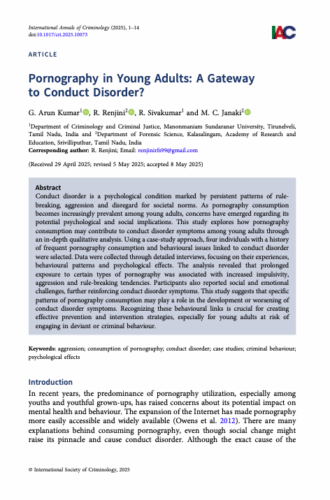Mental Health
Pornography in Young Adults: A Gateway to Conduct Disorder?
Open Access: No.
Abstract
Conduct disorder is a psychological condition marked by persistent patterns of rule-breaking, aggression and disregard for societal norms. As pornography consumption becomes increasingly prevalent among young adults, concerns have emerged regarding its potential psychological and social implications. This study explores how pornography consumption may contribute to conduct disorder symptoms among young adults through an in-depth qualitative analysis. Using a case-study approach, four individuals with a history of frequent pornography consumption and behavioural issues linked to conduct disorder were selected. Data were collected through detailed interviews, focusing on their experiences, behavioural patterns and psychological effects. The analysis revealed that prolonged exposure to certain types of pornography was associated with increased impulsivity, aggression and rule-breaking tendencies. Participants also reported social and emotional challenges, further reinforcing conduct disorder symptoms. This study suggests that specific patterns of pornography consumption may play a role in the development or worsening of conduct disorder symptoms. Recognizing these behavioural links is crucial for creating effective prevention and intervention strategies, especially for young adults at risk of engaging in deviant or criminal behaviour.
Relevance
As far as we know, this study is the first direct assessment of the association between pornography consumption and conduct disorder. In conclusion, repeated exposure to pornographic content, particularly when it becomes habitual or addictive, has been shown to exacerbate behavioural issues that align with the symptoms of conduct disorder, such as physical harm, destruction, lying, cyberbullying, stealing, cruelty, etc.”
Citation
Arun Kumar, G., Renjini, R., Sivakumar, R., & Janaki, M. C. (2025). Pornography in Young Adults: A Gateway to Conduct Disorder? International Annals of Criminology, 1–14. https//doi.org/10.1017/cri.2025.10073

